This article is based on concepts from The Photography Action Cards which are currently 88% off for Black Friday weekend. Also try the discount code photoholiday20 at checkout for extra holiday savings.
Lighthouses are a favorite subject for photographers, because they are romantic. However, some realities can make creating an excellent lighthouse photo challenging.
This article will provide you with some valuable insight into improving your lighthouse pictures, and we will discuss these skill points:
- Composition with a limited point of view
- Spotting problems: crooked horizon, trash cans
- Balancing exposure between the sky and foreground
- Creating sharp photos in a windy environment
- Preparing for variable light conditions and weather
“Lighthouses are not just stone, brick, metal and glass. There’s a human story at every lighthouse; that’s the story I want to tell.” ― Elinor DeWire
Elinore DeWire is an American author that specializes in writing about lighthouses, and her quote is good advice for us photographers.
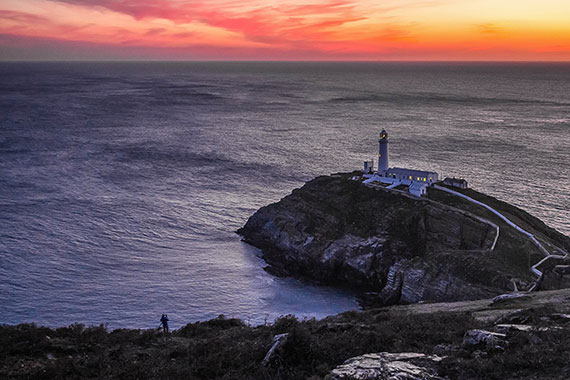
Photo by Pixabay
If you want to create romantic imagery of lighthouses, think about the human connection.
Showcase the sense of isolation and consider the impact a lighthouse would have upon a lonely sailor coming home.
Camera POV—Point of View
Some lighthouses are short and stout. However, the vast majority of lighthouses are tall and imposing structures.
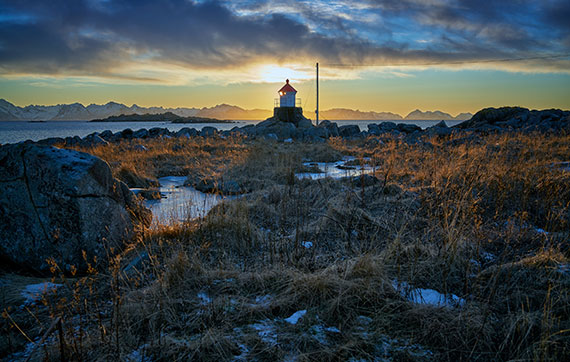
Photo by Vidar Nordli-Mathisen
Pro Tip: The height of the structure will play a critical role in helping you select your POV and lens. If the horizon line is visible, make sure that it is straight and not angled one way or the other.
Tall lighthouses are large and imposing structures. If you get close to the tower, you will likely be limited to a POV that looks upward with a wide-angle lens or a moderate telephoto for close-ups.
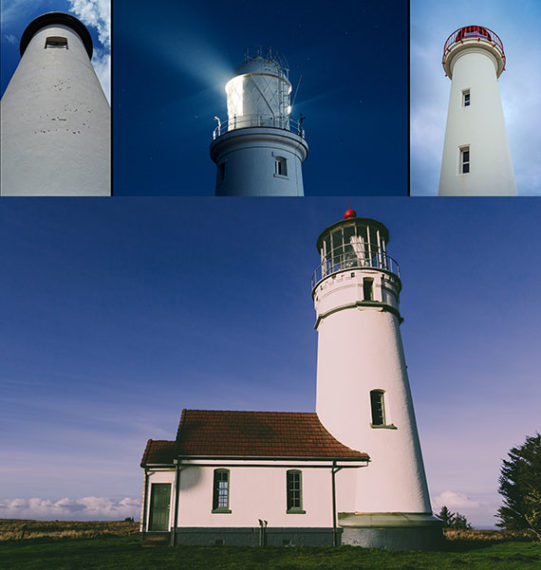
Clockwise from top left: Photos by Daniel Reyes, Louis Reed, Louis Renaudineau and Eric Muhr
While there is nothing wrong with the upward view, it doesn’t lend itself to a romantic lighthouse picture. But by all means, take a few of these shots as well—if you have access.
Critical Point: The romantic POV for a lighthouse will often come from some distance away, rather than close to the site itself. A lighthouse will usually be placed out upon a point of land, and there can be other points of land to either side of it. Look to these areas on either side for a camera position that can include the lighthouse’s surrounding environment, which will create a romantic visual story. A lighthouse is often best captured from an elevated point of view with the water stretching out behind it.
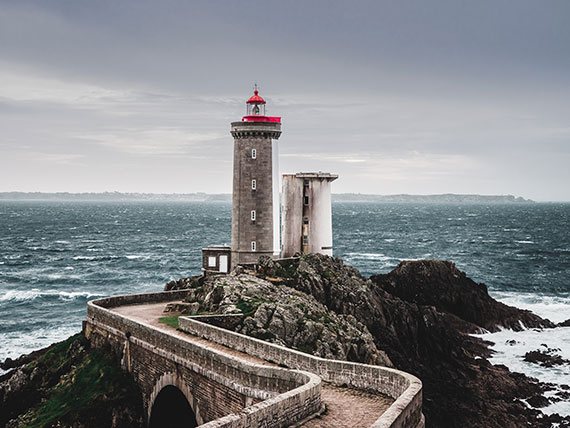
Photo by Raphael Rychetsky
Access to lighthouses can range from complete access, where you can go inside and climb the stairs to the prism, to limited access where you might not even be allowed on the grounds.
Pro Tip: If you live near your subject lighthouse, you can visit it many times and explore different points of view and access moments. If you’re on vacation, and your opportunity is a one-shot deal, it will be worth your time to do some research online. You want to know the access limitations, weather conditions and sunrise and sunset times during your visit.
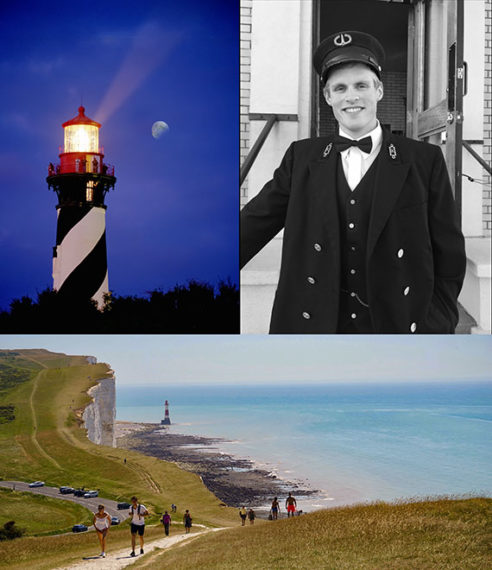
Top photos by Kent DuFault; bottom by Mike
Equipment:
- Camera: Any camera, including a smartphone camera
- Lens: Any lens, but typically, you want a moderate wide-angle to medium telephoto
- Lens Hood: Highly suggested to prevent lens flare
- Filters: Graduated ND and/or a polarizing filter can be convenient and helpful
- Tripod: Best to get one with a sturdy head and a wired or wireless remote shutter release, if you want to give some long-exposure shots a try or plan to shoot in low light
- Flashlight: A great tool if you arrive or leave in the dark, especially if you are walking along cliffs
- App software: Photo Pills (this software, while optional, locates the sunrise and sunset on a map and can help you determine the best shooting location before you arrive)
- Notepad: Take notes and be sure to record location metadata on your camera
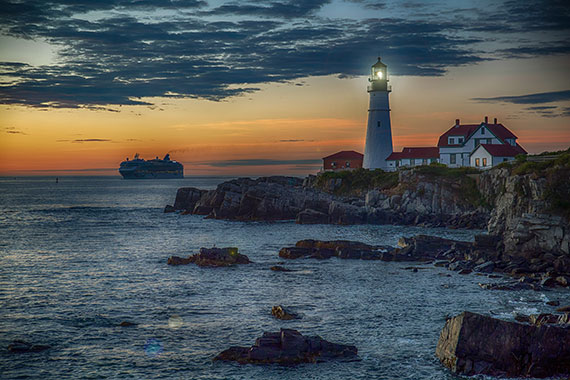
Photo by Keith Luke
Think About This:
Romanticizing a lighthouse picture means adding drama. There are several ways to do this. Including a ship in the background is fabulous addition if you’re lucky enough to see one. You can also include working personnel like the lighthouse keeper, as I did in a previous example photo. Explore all the possibilities.
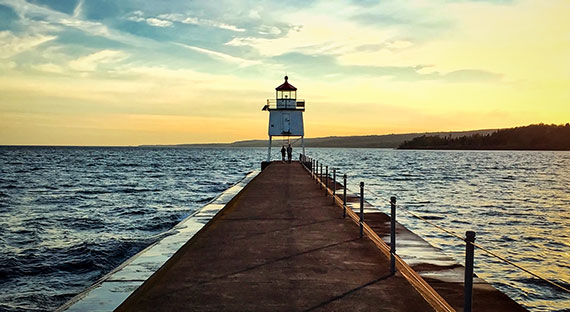
Photo by Kent DuFault
I visited this lighthouse at sunset. The lighting was perfect. However, I wasn’t lucky enough to catch a vessel going in or out of the harbor. Then a couple walked past me and out toward the structure. It was the perfect human element that I needed to create my romanticized lighthouse story.
We’ve all heard the virtues of photographing during the golden hour. With romantic lighthouse photography, the time of day plays a critical role.
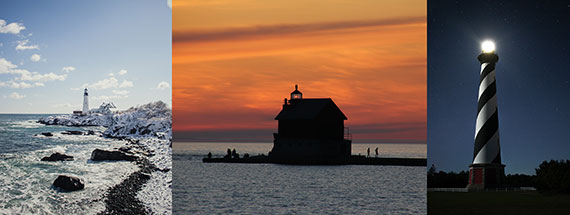
From left: photos by Adam Bixby, James Peacock and Cam Bradford
In the example photos above, the leftmost picture was taken under midday light. The scene is quite extraordinary. However, it lacks romantic drama due to the lighting.
The center photo represents what you might expect around sunrise or sunset, while the rightmost picture results from shooting the lighthouse after sunset in the twilight hour.
Pro Tips!
- Avoid shooting during midday light. If that’s the only opportunity to photograph, consider using some glass filters on your lens. (More on that in a minute.)
- Sunrise and sunset are great options for light. Arrive early. You want to set up and be ready when the magic happens. Bring a flashlight so you can see in the dark. A headlamp also works well.
- Sunrise and sunset can be great for capturing your lighthouse in silhouette. Make sure you select a point of view that places the lighthouse structure against the bright sky.
Post-sunset is a superb time for romantic lighthouse photography. The best shots will occur when there is still some light left in the sky—up to 45 minutes after the sun drops below the horizon.
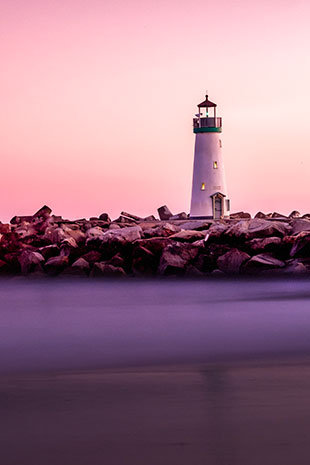
Photo by Everaldo Coelho
Gear Hack!
Let’s say you don’t have an option but to visit your lighthouse subject at midday. This scenario is one of those moments where a colored glass filter on the lens can save the day. You can also accomplish a color wash in post-production.
Pro Tip: If you’re going with a color filter on the lens, keep it light in hue and density. Colors that work well are pink, violet, blue and very light shades of red.
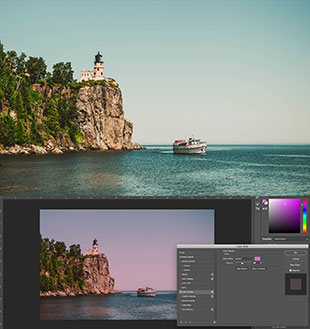
Original photo by Atharva Tulsi; editing by Kent DuFault
The original photo was taken in midday light. It lacked any sense of romance in the lighting.
You can add a color wash to your lighthouse image in Photoshop using the layer style option in the layers palette. Make sure you duplicate the background layer and then highlight it before clicking on layer styles. You cannot use layer styles on the background layer.
You can also add a color wash to a bland lighthouse picture in Lightroom.
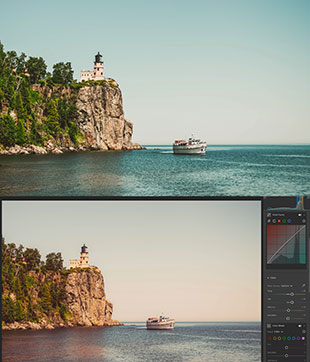
Pro Tip: When creating a color wash in post-production, using a minimalist approach is often more appealing than going with deep shades of color.
In Lightroom, the tools you will use to create a romantic hue of color are curves, color, and the color mixer or HSL (depending upon your version of Lightroom).
Beware of fakes!
Be careful with your post-production!
In this lighthouse picture, the sun was behind the photographer and to the right of the camera. You can tell by the shadows on the buildings.
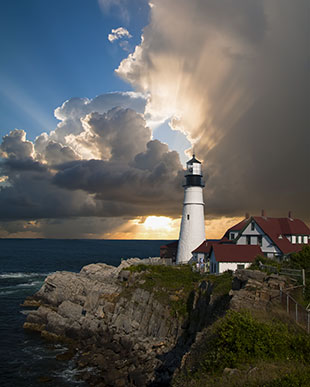
Photo by Pixabay
There must have been a bland sky, and the photographer decided to drop in a sunset.
The problem is that the lighting doesn’t match up—backlighting and front lighting in the same picture?
It is obviously fake.
Become a student of light, and don’t create fake lighting!
Let’s cover a few final critical features to creating romantic lighthouse photos.
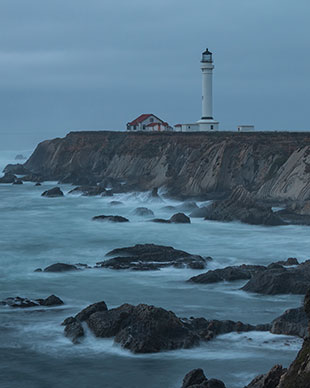
Photo by Cayetano Gil
The weather is a definite dramatic factor in lighthouse photography.
In fact, the worse the weather is, the better.
After all, the very function of the lighthouse is to guide when inclement weather prevents visual contact.
Your chances of the lighthouse lamp being turned on are much higher!
Pro Tip: Inclement weather often brings the wind. You must stabilize your camera, especially if you will try and capture some long exposures (such as in the example photo above.) Having an excellent steady tripod with a decent sized head is crucial. Look for a vantage point that is protected from the wind. Bring some sandbags and bungee tie them to hang down from the tripod between the three legs. There are commercially available sandbags for photography purposes, or you can make your own.
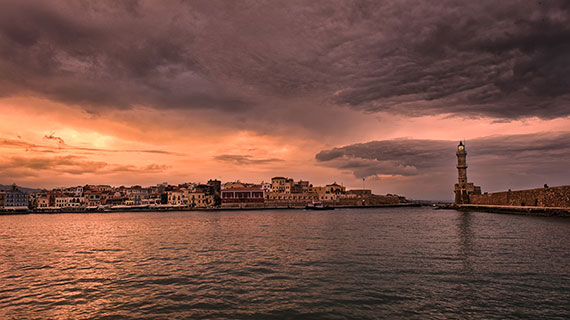
Photo by George Desipris
If a pleasing and storytelling environment surrounds your lighthouse, take some shots that include it.
These are the four lenses that I carry for my lighthouse photography.
- Canon EF 16-35mm f/2.8L III USM
- Canon EF 24-70mm f/2.8L II USM
- Canon EF 70-200mm f/2.8L IS III USM
- Canon EF 300mm f/4L IS USM
If your POV is distant, try to include some meaningful foreground objects to add depth perception.
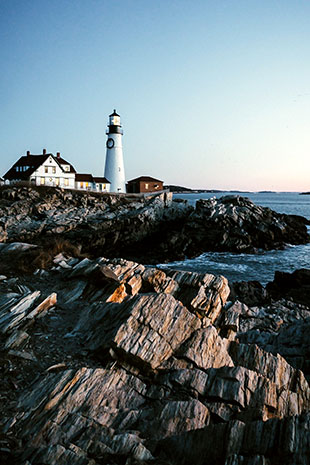
Photo by Mitch McKee
Pro Tip: Keep your eyes sharpened and look for garbage cans, cars, power lines or any object that can interfere with your photo’s romanticized intent.
If you’re down near the water, look for tidepools to catch a reflection for added impact.
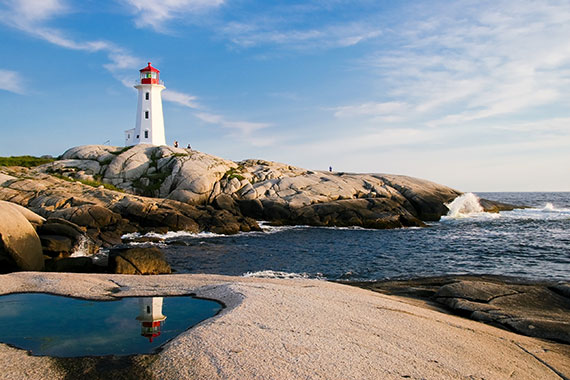
Photo by Pixabay
In Conclusion
- Lighthouses can be tall or short and stout; choose your POV accordingly
- An elevated POV often best portrays the romantic aspect of a lighthouse
- Keep your horizon line straight
- Access can be limited, and you may find your best camera angle from some distance away from the tower
- When possible, include a human element
- You can create dramatic and romantic lighthouse images with any camera—more equipment just gives you more options
- Be aware of the environment—bring a flashlight and watch your footing
- It’s best to shoot a lighthouse at sunrise or sunset; dusk can also create dramatic effects, especially if the lighthouse lamp is on
- You could add color with glass filters or post-production techniques if the lighting is lackluster
- Don’t create a fake-looking picture!
- Inclement weather is your friend
- Include the surrounding landscape if it romanticizes the story of your image
- Including foreground objects adds depth perception
- Reflections can add a neat effect if you’re near the water
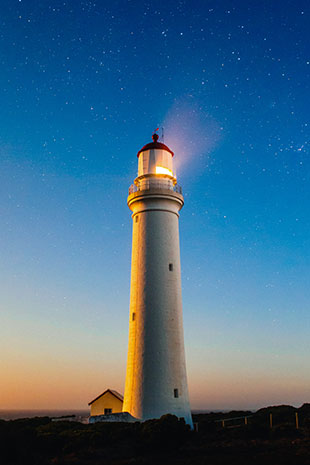
Photo by Joshua Hibbert
Now You Should Give It a Try!
Pick your subject lighthouse.
Do pre-location research online. Try to determine the best time of day and angle. Depending upon the location, plan to shoot at sunrise or sunset.
Use the following camera settings:
- Manual mode or aperture priority mode
- Drive mode to single shot
- Mount the camera to a tripod and use a remote shutter release
- Start at ISO 200 (adjust as necessary)
- Maintain a shutter speed of 1/15th or faster for wide-angle lenses, and 1/60th or faster for longer telephoto lenses
- Use all the focusing points
- Set the metering mode to matrix/evaluative/pattern
- Use single shot focus mode
- Set the white balance to auto
- Shoot in camera raw (additional .jpeg optional)
- Adjust aperture from f/2.8 to f/11 depending upon the depth of field
- Use a foreground object if possible
How did you do?
- Did you correctly place the focus for the intended depth of field window?
- Is the lighthouse sharp and free of camera shake?
- Did you compose the image using the sample pictures for ideas?
- Is your image free of unwanted humanmade objects (garbage cans, etc.)?
- Did you frame the shot tight enough or wide enough?
- Does your photo convey the romance of the location?
- Is the color pleasing? (It doesn’t need to be accurate)
- Is your exposure balanced between the sky and foreground?
- Did you experiment with motion blur in the water while keeping the lighthouse sharp?
About the Author:
Kent DuFault is an author and photographer with over 35 years of experience. He’s currently the director of content at the online photography school, Photzy.
For Further Training:
Expand your shooting skills with 65 beautifully designed & printable project sheets that will give you over 200 photography assignments, covering everything you can imagine! The Photography Action Cards are currently 88% off until Black Friday. Also try the discount code photoholiday20 at checkout for extra holiday savings.
These Action Cards discuss a photographic topic, provide you with suggested considerations, and give you specific photographic assignments. They’ll kick you out of the “nest” to go have a personal discovery experience all on your own.
Deal ending soon: The Photography Action Cards at 88% Off
Go to full article: Lighthouse Photography Tips
What are your thoughts on this article? Join the discussion on Facebook
PictureCorrect subscribers can also learn more today with our #1 bestseller: The Photography Tutorial eBook
The post Lighthouse Photography Tips appeared first on PictureCorrect.
from PictureCorrect https://ift.tt/37wH6d5
via IFTTT







0 kommenttia:
Lähetä kommentti